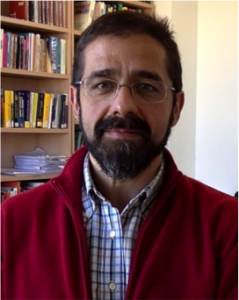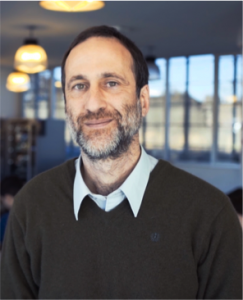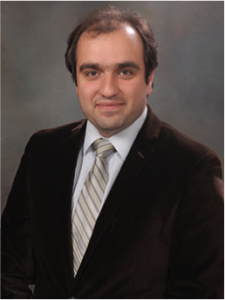Plenary Session Speaker Biographies and Presentation Details
- Professor Antonio Caamaño
 Antonio Caamaño holds a degree in Theoretical Physics from the Universidad Autónoma de Madrid (UAM) and a PhD in Telecommunications. He received the B.Sc. and Ms.C. degrees in Theoretical Physics in 1995 from the Autónoma University of Madrid and his Ph.D. in Telecommunications Engineering from the Carlos III University of Madrid in 2003. Since 2003 he is Associate Professor in the Department of Signal Theory and Communications at Rey Juan Carlos University in Madrid, Spain. His main research interests lie in the fields of MANET optimization, bioengineering and statistical signal processing, particularly Big Data techniques. His most recent contributions relate to practical applications of all those fields to traffic flow and climate change estimation.
Antonio Caamaño holds a degree in Theoretical Physics from the Universidad Autónoma de Madrid (UAM) and a PhD in Telecommunications. He received the B.Sc. and Ms.C. degrees in Theoretical Physics in 1995 from the Autónoma University of Madrid and his Ph.D. in Telecommunications Engineering from the Carlos III University of Madrid in 2003. Since 2003 he is Associate Professor in the Department of Signal Theory and Communications at Rey Juan Carlos University in Madrid, Spain. His main research interests lie in the fields of MANET optimization, bioengineering and statistical signal processing, particularly Big Data techniques. His most recent contributions relate to practical applications of all those fields to traffic flow and climate change estimation.
New Approaches to Wireless Communications to Traffic Flow Sensing and Beyond
Historically, the measurement of traffic flow, whether it be vehicular, cyclist or pedestrian, has been tied to fixed infrastructures. Sensors such as induction loop detectors, cameras, occupancy and pass sensors have been used to estimate traffic flow and density. They have largely shaped the understanding of traffic flow measurement and theory through obvious limitations such as fixed positions, limited coverage areas or time averages of sampling. Deployment and maintenance costs have also limited their large scale introduction. Only recently, due to the ubiquity of mobile phones equipped with a plethora of sensors (GPS, gyroscopes, magnetometers and accelerometers), has the paradigm changed to decentralized traffic flow measurement. However, new limitations come into play as wireless coverage, cost of bandwidth or, more importantly, privacy and security issues are more apparent than ever. We will see how to take advantage of these and other wireless technologies (such as MANETs) to acquire accurate measurements that not only allow us to get similar but much more efficient estimates of traffic flow. Practical experimental results of traffic flow measurements in Madrid and Washington, D.C. will be presented to further illustrate this upcoming paradigm.
- Professor Daniel Parisi
 Dr. Daniel R. Parisi holds a degree in Physics from the University of Buenos Aires (UBA, Argentina) and two doctorate degrees in Engineering from UBA and from the National Institute of Applied Science (INSA-Rennes, France). He is Associate Professor at the Buenos Aires Institute of Technology (ITBA, Argentina) and Scientific Researcher at the National Council of Scientific and Technological Research (CONICET, Argentina). His scientific and technological production involves the study of systems composed of many physical and social agents such as, crowd physics and pedestrian dynamics. The focus of this research has been to apply this knowledge to optimize the design of complex buildings in which intense pedestrian transit occurs. He cofounded the technology-based company Urbix Technologies S.A. (www.urbix.com.ar), where he led the development of the pedestrian traffic simulation software "SmartCrowd". He provided advisory services for the design, operation and safety of several pedestrian facilities (terminal and transfer stations in transportation systems, indoor stadium, large shopping centers, among others). Dr. Parisi was invited scientist at Dirk Helbing’s group at ETH-Zurich (Switzerland) and at the University of Navarra (Spain), where he continues a fruitful collaboration with Iker Zuriguel and colleagues. Also, he is the director of the “In3D” Center at the Computer Engineering Department at ITBA where he continues developing experimentally validated models of pedestrian dynamics that increasingly approach the real pedestrian systems.
Dr. Daniel R. Parisi holds a degree in Physics from the University of Buenos Aires (UBA, Argentina) and two doctorate degrees in Engineering from UBA and from the National Institute of Applied Science (INSA-Rennes, France). He is Associate Professor at the Buenos Aires Institute of Technology (ITBA, Argentina) and Scientific Researcher at the National Council of Scientific and Technological Research (CONICET, Argentina). His scientific and technological production involves the study of systems composed of many physical and social agents such as, crowd physics and pedestrian dynamics. The focus of this research has been to apply this knowledge to optimize the design of complex buildings in which intense pedestrian transit occurs. He cofounded the technology-based company Urbix Technologies S.A. (www.urbix.com.ar), where he led the development of the pedestrian traffic simulation software "SmartCrowd". He provided advisory services for the design, operation and safety of several pedestrian facilities (terminal and transfer stations in transportation systems, indoor stadium, large shopping centers, among others). Dr. Parisi was invited scientist at Dirk Helbing’s group at ETH-Zurich (Switzerland) and at the University of Navarra (Spain), where he continues a fruitful collaboration with Iker Zuriguel and colleagues. Also, he is the director of the “In3D” Center at the Computer Engineering Department at ITBA where he continues developing experimentally validated models of pedestrian dynamics that increasingly approach the real pedestrian systems.
Clogging in Particle Flows: from Granular Matter to Pedestrians
In this talk, we are going to present the general features of clogging in granular flows and its relation with other systems of frictional particles. To this end, we will present recent experimental results of vibration-driving-vehicles, sheep and humans. We will discuss the differences and similarities between them. In the case of pedestrian, we will analyze the trajectories obtained from a set of controlled evacuation experiment under competitive conditions. This data suggest that density may be not enough to describe the state of the system, evidencing that at least another variable may be required. Finally, we will delimit the validity of extrapolating conclusions to
real crowds from other “similar” systems.
- Professor Alireza Talebpour
 Dr. Talebpour is an assistant professor in the Zachry Department of Civil Engineering at Texas A&M University. He received his BS and MS degrees in Civil Engineering from Sharif University of Technology and his PhD in Civil Engineering from Northwestern University. His expertise is in traffic flow theory and modeling user interactions and their impacts on safety and congestion. He has developed simulation tools capable of modeling connected and automated vehicles to capture the impacts of these technologies on transportation system safety and efficiency. Currently, his research is focused on automated vehicles and platooning. He designed and built the Texas A&M’s autonomous Kia Soul in collaboration with TEES and NVIDIA
Dr. Talebpour is an assistant professor in the Zachry Department of Civil Engineering at Texas A&M University. He received his BS and MS degrees in Civil Engineering from Sharif University of Technology and his PhD in Civil Engineering from Northwestern University. His expertise is in traffic flow theory and modeling user interactions and their impacts on safety and congestion. He has developed simulation tools capable of modeling connected and automated vehicles to capture the impacts of these technologies on transportation system safety and efficiency. Currently, his research is focused on automated vehicles and platooning. He designed and built the Texas A&M’s autonomous Kia Soul in collaboration with TEES and NVIDIA
Traffic Flow Dynamics in a Connected, Automated Transportation System
Surface transportation systems face safety, mobility, and reliability issues. The traditional solutions (e.g., building more roads and/or more road capacity) require significant resources. One alternative to this approach is to utilize new technologies, including connectivity and automation, to develop cost-effective solutions. The introduction of connectivity and automation, however, is expected to change the interactions among roadway users, and consequently, will change the underlying dynamics of traffic flow. Understanding these changes is critical for the development of these cost-effective solutions. This talk will present our recent advances in modeling the user interactions in a connected, automated transportation system and will discuss how these technologies will enable user collaboration throughout this system.
